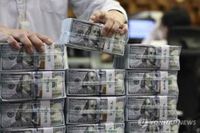On the morning of August 19, 2025, the Seoul foreign exchange market opened with a distinct sense of anticipation. The won-dollar (KRW/USD) exchange rate futures price started the day at 1,388.5 won, a 3.5-won increase from the previous trading session, according to reporting from Asia Economy and Financial News. For market participants, this modest uptick was anything but routine—it was the latest twist in a story shaped by global uncertainty, shifting risk appetites, and the ever-present forces of supply and demand.
As the clock ticked past 9:00 a.m., the exchange rate continued to fluctuate, ranging between 1,398.7 and 1,389.3 won, as detailed by HelloT. The early trading session reflected a market still digesting the latest round of international developments, most notably high-profile diplomatic efforts in Washington, D.C. the day before. On August 18, U.S. President Donald Trump, Ukrainian President Volodymyr Zelensky, and several key European leaders had convened at the White House to discuss a possible end to the war in Ukraine. While the meeting made headlines, it failed to yield any concrete breakthrough, leaving investors and analysts to weigh its implications for global risk sentiment and currency flows.
According to HelloT, the lack of a decisive outcome from the White House summit contributed to a weakening of risk appetite among investors. This, in turn, lent strength to the U.S. dollar—a classic pattern in times of heightened uncertainty. The dollar index, which tracks the greenback against a basket of six major currencies, rose by 0.24% to reach 98.143. The market’s reaction was swift, with the won-dollar futures price reflecting the shift in sentiment almost immediately. The spot exchange rate, meanwhile, was reported at 0.24% lower, also at 98.143 won, underscoring the market’s sensitivity to both global headlines and underlying economic fundamentals.
But international politics weren’t the only force at play. Domestic analysts pointed to a complex interplay of supply and demand factors driving the exchange rate’s trajectory. Min Kyung-won, a senior researcher at Woori Bank, told Opinion News, “Today, the dollar-won is expected to rise on the back of weakened risk appetite and real demand for the dollar.” She added, “Although President Trump held a series of meetings with Ukraine and European leaders, there was no clear result, so the market didn’t respond strongly. Instead, uncertainty about the Fed’s policy has increased demand for the dollar, leading to its strength.”
Min went on to note that the domestic stock market was also feeling the effects of this uncertainty, with major technology stocks showing mixed performance and the potential for continued weakness in the Korean equity markets. “With continued net selling by foreign investors and settlement demand from importers holding the upper hand in the domestic market, the upward pressure on the exchange rate is likely to dominate,” she explained. Yet, she was quick to point out that the situation was far from one-sided. “Exporters’ high-point selling and the foreign exchange authorities’ vigilance regarding micro-adjustments are factors supporting the upper end of the exchange rate,” Min said.
This delicate balance was evident in trading patterns observed the previous day. As the exchange rate approached the psychologically significant 1,390-won level, exporters stepped in to sell dollars, providing a counterweight to the upward momentum. “Yesterday, when the exchange rate reached the 1,390-won psychological high during weekly trading, exporters’ high-point selling patterns emerged. Considering this, if the rate rises further today, negotiation volume is expected to balance supply and demand,” Min analyzed. She also noted that the authorities might intervene to manage volatility, stating, “With the possibility of the authorities stepping in to manage exchange rate volatility, the likelihood of excessive long sentiment today seems low.”
Beyond the headline figures, the market was also keeping a close eye on other currency pairs. The won-yen (KRW/JPY) exchange rate futures price was reported at 938.87 won per 100 yen, a 0.4-won decrease from the previous day’s closing price, according to HelloT. Meanwhile, the yen-dollar (JPY/USD) exchange rate saw a 0.35% rise, reaching 147.96 yen. These movements hinted at the broader dynamics influencing the won-dollar exchange rate, including shifts in international capital flows and the relative strength of major currencies.
Behind the scenes, central banks were playing their part. On August 18, the U.S. Federal Reserve and the Bank of Korea held discussions regarding the won-dollar exchange rate, as reported by Opinion News. The outcome of these talks, while not made public in detail, was widely interpreted as a sign that policymakers were closely monitoring the situation and stood ready to act if necessary. Concerns about potential foreign exchange interventions and ongoing geopolitical tensions only added to the sense of vigilance in the market.
It’s worth noting that the exchange rate’s recent movements weren’t solely the result of short-term news. The underlying fundamentals—South Korea’s trade balance, the flow of international investment, and the country’s exposure to global economic cycles—remained critical. The interplay of these factors with daily trading activity, speculative sentiment, and official policy decisions created an environment where the won-dollar exchange rate could swing sharply in response to new information.
For importers and exporters, these fluctuations have real-world consequences. A stronger dollar can make imported goods more expensive and squeeze margins for companies reliant on foreign inputs. Conversely, Korean exporters may find their products more competitively priced abroad, at least in the short term. The challenge for businesses and policymakers alike is to navigate this ever-changing landscape, balancing the risks and opportunities that come with currency volatility.
As the trading day progressed, market participants continued to watch for signs of intervention or shifts in sentiment. Would the authorities step in to smooth out the volatility? Would a new round of international negotiations bring clarity to the geopolitical picture? Or would supply and demand dynamics assert themselves, as they so often do, in ways that defy easy prediction?
The story of the won-dollar exchange rate on August 19, 2025, is a reminder that even modest movements in financial markets can reflect a world in flux. From the corridors of power in Washington to the trading floors of Seoul, the forces shaping currency values are as varied as they are unpredictable. For now, all eyes remain on the numbers—and the next headline that might send them moving once again.

